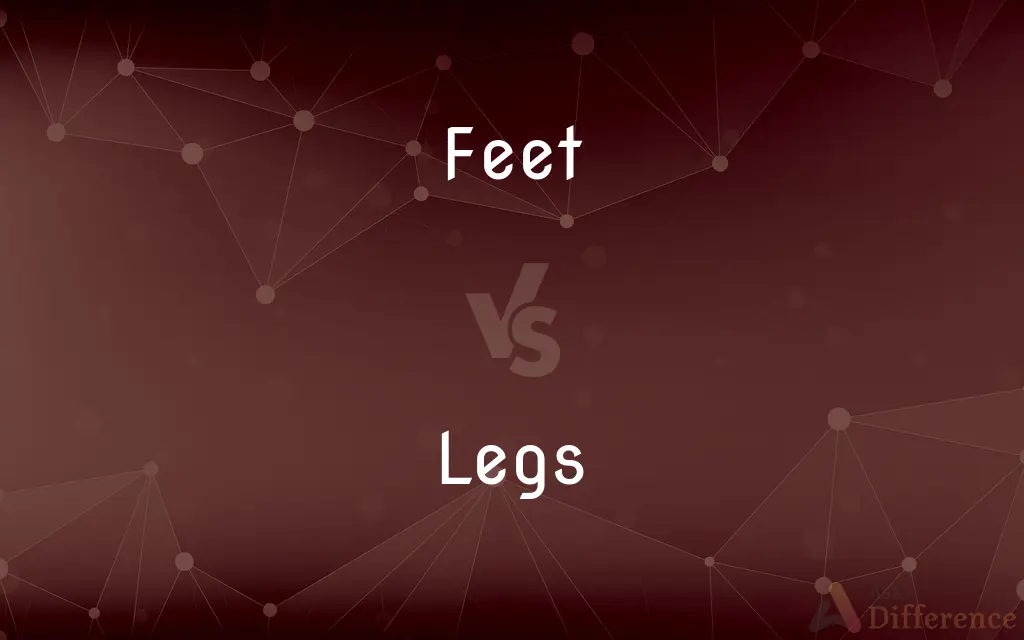Feet vs. Legs — What's the Difference?
Edited by Tayyaba Rehman — By Urooj Arif — Updated on April 16, 2024
Feet are the lower extremity of the leg below the ankle, responsible for bearing weight and walking, whereas legs support the body, enable locomotion and consist of upper and lower parts.

Difference Between Feet and Legs
Table of Contents
ADVERTISEMENT
Key Differences
Feet are anatomically designed for stability and movement, equipped with bones, muscles, and joints specialized for weight-bearing and mobility. In contrast, legs function as the primary support structure for the human body, comprising the thigh, knee, and shin, crucial for supporting the entire weight of the body and facilitating movement.
The foot's structure, including the arch and toes, plays a vital role in balance and fine motor movements, such as tiptoeing or standing on one foot. Meanwhile, the leg houses major muscle groups like the quadriceps and hamstrings, which are essential for major movements like running and jumping.
Feet contain 26 bones, each playing a crucial role in mobility and balance, forming joints like the ankle that allow diverse movements. On the other hand, the leg consists of larger bones such as the femur, tibia, and fibula, which are stronger and support significant loads.
The health of the feet often affects localized functions, such as walking or standing, with common issues like flat feet or plantar fasciitis impacting daily activities. Conversely, leg health is critical for overall mobility, with conditions like fractures or arthritis having a more extensive impact on the body’s ability to move.
From a sensory perspective, feet are highly sensitive, containing numerous nerve endings that help detect surface variations when walking. Legs, however, are less sensitive but crucial in responding to the body's movement needs and balance requirements.
ADVERTISEMENT
Comparison Chart
Function
Provide stability and mobility, help in balance.
Support the body, enable walking and running.
Major Bones
Tarsals, metatarsals, phalanges.
Femur, tibia, fibula.
Common Conditions
Plantar fasciitis, bunions.
Arthritis, fractures.
Sensitivity
High, due to numerous nerve endings.
Lower, primarily muscular and structural.
Muscle Groups
Smaller muscles for fine movement.
Large muscles like quadriceps, hamstrings.
Compare with Definitions
Feet
The lower extremity of the leg below the ankle, used for standing and moving.
She dipped her feet in the pool to cool off.
Legs
In various sports, a period or division of a game.
He did well in the first leg of the tournament.
Feet
Used to denote the presence or attachment on a base or lower part.
The ladder feet were securely positioned on the ground.
Legs
A section or stage of a journey or process.
The final leg of the trip was the most scenic.
Feet
The part of a sock or shoe that covers this area.
He has a hole in the toe of his sock right where his feet rub against the shoe.
Legs
Each of the supports of a chair, table, or other structure.
The antique desk had ornately turned legs.
Feet
The bottom part of a piece of furniture.
The feet of the table are carved in an ornate style.
Legs
A part of a garment that covers the legs.
These pants have legs that are slightly too long for him.
Feet
A unit of measurement equal to 12 inches.
The room is 10 feet wide.
Legs
The limbs on which a person or animal walks and stands.
After running the marathon, her legs felt incredibly weak.
Feet
Plural of foot.
Legs
One of the limbs or appendages that an animal uses for locomotion or support.
Feet
See Foot.
Legs
One of the lower or hind limbs in humans and other primates.
Feet
Fact; performance.
Legs
The part of the limb between the knee and foot in vertebrates.
Legs
The back part of the hindquarter of a meat animal.
Legs
A supporting part resembling a leg in shape or function.
Legs
One of the branches of a forked or jointed object.
Legs
The part of a garment, especially of a pair of pants, that covers the leg.
Legs
(Mathematics) Either side of a right triangle that is not the hypotenuse.
Legs
(Nautical) The distance traveled by a sailing vessel on a single tack.
Legs
The part of an air route or a flight pattern that is between two successive stops, positions, or changes in direction.
Legs
One of several contests that must be successfully completed in order to determine the winner of a competition.
Legs
(Sports) One stretch of a relay race.
Legs
Legs The narrow streams of swirled wine or spirits that run slowly down along the inside of a glass, often believed to indicate that the liquid is full-bodied.
Legs
Legs(Slang) The ability to last or sustain success, especially by appealing to an audience
A blockbuster movie that has legs.
Legs
To go on foot; walk or run. Often used with the indefinite it
Because we missed the bus, we had to leg it across town.
Legs
Plural of leg
Legs
(bingo) eleven
Legs
Viscous streaks left on the inside of the glass when certain wines are swirled around before tasting.
Legs
Staying power;
That old Broadway play really has legs
Common Curiosities
What are the main parts of the leg?
The main parts of the leg are the thigh, knee, and shin.
What muscles are prominent in the legs?
The quadriceps and hamstrings are prominent muscles in the legs.
What is a common condition that affects the feet?
Plantar fasciitis is a common condition that affects the feet.
What role do the nerves in the feet play?
The nerves in the feet help detect surface variations and contribute to balance.
How many bones are in a human foot?
There are 26 bones in a human foot.
How do feet contribute to balance?
Feet contribute to balance through their structure, including arches and toes.
What is a common use of the word 'feet' outside anatomy?
'Feet' is commonly used as a unit of measurement, equal to 12 inches.
What is the primary function of feet?
The primary function of feet is to provide stability and mobility.
Can issues with the legs affect overall mobility?
Yes, issues with the legs, like fractures or arthritis, can significantly affect overall mobility.
How do feet and legs work together in movement?
Feet and legs work together to facilitate movement by combining stability and strength.
What are the functions of the muscles in the feet?
The muscles in the feet are responsible for fine motor movements.
What's the difference between leg bones and foot bones?
Leg bones include the femur, tibia, and fibula, which are larger and stronger, while foot bones include smaller bones like tarsals and metatarsals.
What conditions commonly affect the legs?
Conditions like arthritis and fractures commonly affect the legs.
How does the structure of legs support the body?
The structure of the legs, including strong bones and muscles, supports the body and enables major movements.
Why are feet more sensitive than legs?
Feet are more sensitive than legs due to a higher concentration of nerve endings.
Share Your Discovery

Previous Comparison
Nursing vs. Nursery
Next Comparison
Ideologist vs. IdeologueAuthor Spotlight
Written by
Urooj ArifUrooj is a skilled content writer at Ask Difference, known for her exceptional ability to simplify complex topics into engaging and informative content. With a passion for research and a flair for clear, concise writing, she consistently delivers articles that resonate with our diverse audience.
Edited by
Tayyaba RehmanTayyaba Rehman is a distinguished writer, currently serving as a primary contributor to askdifference.com. As a researcher in semantics and etymology, Tayyaba's passion for the complexity of languages and their distinctions has found a perfect home on the platform. Tayyaba delves into the intricacies of language, distinguishing between commonly confused words and phrases, thereby providing clarity for readers worldwide.
















































